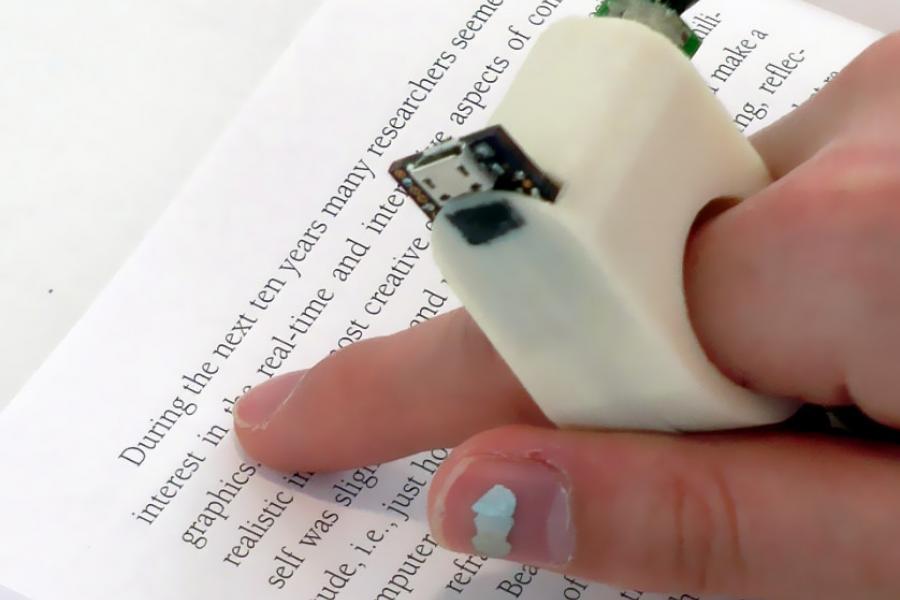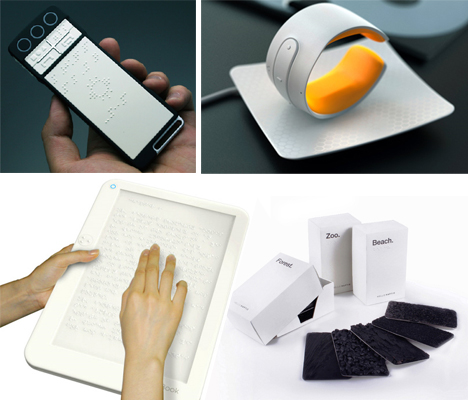Discover Innovative Tools Made for the Aesthetically Damaged
The advancement of innovative devices for the visually impaired stands for a substantial improvement in ease of access and independence. Technologies such as smart glasses with AI capacities and mobile applications designed to give auditory summaries are reshaping daily experiences for users. Additionally, wearable gadgets that employ haptic responses improve ecological understanding, while contemporary Braille innovations supply new methods to involve with text. As these devices proceed to evolve, their effect on the lives of those with visual disabilities increases essential inquiries about the future of inclusivity and autonomy in numerous facets of life. What exists in advance in this technological landscape?
Smart Glasses for Navigating

Smart glasses made for navigating are transforming the way visually damaged individuals communicate with their setting. These sophisticated gadgets utilize a mix of video camera modern technology, expert system, and auditory comments to offer real-time info concerning environments. By employing challenge detection systems, smart glasses can notify users to prospective dangers, allowing more secure mobility in both acquainted and unknown setups.
The integration of GPS technology even more boosts navigation capabilities, allowing customers to get auditory instructions as they move. This hands-free method not only promotes independence but additionally empowers visually damaged individuals to browse city landscapes with boosted confidence. In addition, several clever glasses are furnished with functions that identify sites and street indications, offering contextual details that improves the customer experience.
Furthermore, the advancement of these tools is continually advancing, with firms working to improve the precision of object acknowledgment and broaden the variety of navigational features. As wise glasses end up being a lot more cost effective and obtainable, they hold the potential to significantly change everyday life for aesthetically impaired customers. Inevitably, these innovative devices represent an important action towards inclusivity, offering enhanced movement and a greater sense of freedom for people navigating the world around them.

Mobile Apps for Daily Living
Exactly how can mobile applications enhance the lives of visually damaged individuals? Mobile apps are revolutionizing the method visually damaged individuals browse their atmospheres, manage everyday jobs, and access information. These applications supply necessary support with various performances, cultivating freedom and improving lifestyle.
Several innovative mobile apps are made specifically for everyday living. Applications like Be My Eyes link aesthetically damaged individuals with sighted volunteers via video phone calls, enabling them to obtain real-time support with jobs such as reading labels or navigating strange rooms. In A Similar Way, Seeing AI, created by Microsoft, utilizes man-made intelligence to define environments, read text, and recognize things, properly changing a smart device into an effective device for daily help.
In addition, navigating applications tailored for the aesthetically impaired, such as Aira and BlindSquare, provide audio-based directions and environmental details, enabling users to traverse their surroundings safely and with confidence. Beyond navigation and prompt support, mobile apps likewise sustain organization and task management, with attributes that assist users establish pointers, develop to-do checklists, and track consultations. In summary, mobile applications offer as indispensable resources, encouraging aesthetically damaged individuals to lead more independent and fulfilling lives.
Wearable Technologies for Assistance
Empowerment with innovation is progressively obvious in the realm of wearable devices developed to help aesthetically damaged people. These cutting-edge tools integrate flawlessly right into day-to-day live, improving navigating and providing necessary responses to customers. For example, clever glasses furnished with video cameras can review and recognize faces text out loud, permitting users to connect more confidently in expert and social setups.
An additional significant development is using haptic comments systems in wearable gadgets. These systems use resonances or various other responsive signals to fyi eye doctors convey info regarding the individual's environment, such as challenges or changes in terrain, enhancing flexibility and security. Wearable technologies also include wristbands that connect to mobile phones, informing individuals to alerts via refined vibrations, hence boosting connection without dependence on visual signs.
As these modern technologies proceed to progress, they are not just enhancing self-reliance for visually impaired individuals but likewise fostering a better feeling of incorporation in culture. By connecting the gap between challenges encountered in day-to-day living and the possibility for freedom, wearable modern technologies function as crucial devices in the pursuit for equal rights and empowerment for those with aesthetic disabilities.
Sound Description Tools
Sound summary tools play a crucial duty in boosting availability for aesthetically impaired individuals, giving them with the capability to engage with visual media. Smart glasses for the visually impaired. These tools offer narrated summaries of essential aesthetic elements in films, television shows, and live efficiencies, ensuring that customers can completely understand the context and emotions communicated through visuals
Sound description can be incorporated into different systems, consisting of streaming solutions, cinema testings, and live cinema. Lots of preferred streaming services now include audio description as an accessibility attribute, allowing audiences to choose it easily. In addition to traditional media, specialized apps also exist, giving audio descriptions for art exhibitions, museums, and other social events.
The performance of audio summary hinges on the ability of the storytellers, who must communicate aesthetic information succinctly without interfering with the initial sound. Developments in this area are additionally leading the way for even reference more tailored experiences, where customers can change the level of information and pacing according to their choices.
Braille Innovations and Devices
Braille tools and technologies have considerably transformed the way aesthetically damaged individuals connect with message and info. Modern advancements have resulted in the growth of versatile tools that improve literacy and independence amongst users. Significantly, Braille show technologies have advanced, allowing for vibrant reading experiences. These gadgets convert digital message right into Braille, making it possible for customers to access a vast variety of details on smart devices, computer systems, and tablet computers.
Furthermore, mobile Braille notetakers integrate traditional Braille input with contemporary performances, promoting note-taking, scheduling, and document editing on the move. Wearable technology for low vision. These compact gadgets frequently include text-to-speech capabilities, bridging the space between Braille and auditory information
Additionally, cutting-edge Braille printers have emerged, permitting individuals to create Braille labels, documents, and instructional products effectively. This accessibility cultivates better participation in instructional and expert environments, inevitably advertising inclusivity.
In addition, research into smart Braille modern technologies continues to broaden. Devices extended wear contacts that include expert system are being discovered to provide real-time navigating help and contextual info, improving the user experience in diverse setups. Generally, these developments mirror a dedication to empowering visually impaired individuals through innovation, guaranteeing they can quickly accessibility and involve with the world around them.

Conclusion
The advancement of innovative tools for the aesthetically damaged substantially boosts independence and high quality of life. Smart glasses, mobile applications, wearable technologies, audio description devices, and Braille technologies jointly equip individuals by offering crucial navigation assistance, ecological understanding, and boosted analysis experiences. These innovations not just foster greater addition yet additionally promote autonomy in daily tasks, ultimately adding to an extra available and fair society for visually damaged individuals. Proceeded advancement in this field holds assurance for more enhancements.
As smart glasses become extra accessible and cost effective, they hold the prospective to considerably transform everyday life for aesthetically impaired individuals. Mobile apps are revolutionizing the way visually damaged customers browse their environments, take care of daily jobs, and accessibility information. Apps like Be My Eyes connect visually damaged individuals with sighted volunteers by means of video clip phone calls, enabling them to get real-time aid with tasks such as checking out tags or navigating unknown rooms.Additionally, navigating applications tailored for the visually impaired, such as Aira and BlindSquare, supply audio-based directions and environmental information, enabling customers to traverse their surroundings safely and with confidence.The development of cutting-edge devices for the visually damaged dramatically improves self-reliance and high quality of life.